Nonfiction - Nonfiction (English spelling)
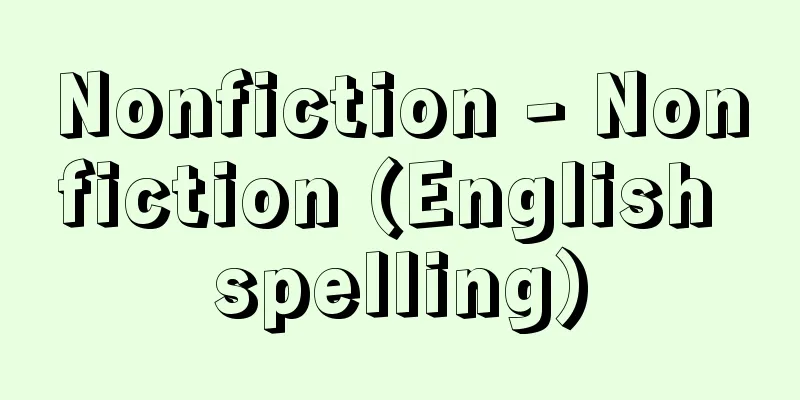
|
Akira Haruna (1935-) defines non-fiction as "a work of linguistic expression based on fact, other than literature" (Encyclopedia of Modern Japanese Literature). However, it seems that the limitation of "other than literature" in this definition can be removed. This is because non-fiction works are now recognized as fine literary works and occupy a large position in the world of contemporary literature. [Minato Kawamura] Foreign non-fictionIn ancient Greece, there were "myths" as stories of the gods, and "history" as stories of the people. Homer's "Iliad" and "Odyssey" were considered "mythical stories (= prototypes of fiction)" as stories between gods and humans, but Schliemann's excavation of the ruins proved that they were works of non-fiction, based on real history. Historical books such as the Histories of Herodotus and Thucydides, Caesar's The Gallic Wars, and Sima Qian's Records of the Grand Historian can be said to be the earliest works of non-fiction, and they came to be separated and classified as a genre from myths, which are stories of the gods, and their developed forms, such as legends, fantastic tales, fairy tales, and romances, which are fiction (= fiction, novels). Even in modern times, non-fiction works such as John Reed's Ten Days That Shook the World (1919) and Edgar Snow's Red Star Over China (1937) have been written as documentaries closely related to revolutions and wars, but it was only after World War II that the term "non-fiction" came to be used to consolidate various genres such as documentary literature and documentary, when American journalism began to write non-fiction works that were different from traditional records, reports, or true stories. A representative example is Truman Capote's In Cold Blood (1966). Of course, there were non-fiction works (travelogues, records, reports) written by famous novelists before that, such as André Gide's "A Journey Through the Soviet Union" (1936) and George Orwell's "Homage to Catalonia" (1938). However, it is only in recent years that non-fiction has come to be recognized as a literary work, both in Europe, the United States, and Japan. [Minato Kawamura] Japanese non-fictionNon-fiction works have been registered in the history of Japanese literature under the names of documentary literature and reportage literature. Examples include Yokoyama Gennosuke's "Nihon no Kasho Shakai" (1899), Matsubara Iwagoro's (1866-1935) "Darkest Tokyo" (1926), and Hosoi Wakizo's "Jokojo Soraishi" (1925). However, the genre of non-fiction literature in recent years has been somewhat different in style from these earlier works, and has attracted much attention with the appearance of Tachibana Takashi and Kodama Takaya (1937-1975), who suddenly came into the limelight with their "Study on Tanaka Kakuei" in 1974 (Showa 49), against the backdrop of so-called new journalism. The terms non-fiction writer and non-fiction literature became commonplace, and literary awards such as the Oya Soichi Non-Fiction Award for non-fiction works were established. Several novelists are thought to have been instrumental in establishing the genre of nonfiction literature. It was Sakaguchi Ango who invigorated this field after the Second World War, and works such as Ango Kodan (1950) and Ango Shin Nihon Chiri (1951) were clearly the beginnings of postwar nonfiction. These were not essays or short stories written by novelists for leisure, but rather serious creative endeavors by writers dealing with social phenomena, events, reality and facts (even if they may seem like the product of some leisure time). Kaiko Takeshi attempted to write such non-fiction works in a more contemporary context. In addition to writing novels such as Katasumi no Meiro (The Labyrinth in the Corner) (1962), which were based on the real-life case of a falsely accused Tokushima radio operator murder, he also wrote reportage works such as Zubari Tokyo (Tokyo in Situ) (1964) and Vietnam Senki (The Vietnam War Chronicle) (1965), in which he reported on modern society and modern warfare from the chimera-like metropolis of Tokyo and from the Vietnam War, a place where global contradictions converge. Another non-fiction novelist is Toshiyuki Kajiyama. He made a name for himself with his industrial espionage novels such as "Black Test Car" (1962), and as a reporter for a weekly magazine and a writer of reportage articles, he led the "top-ya" non-fiction writers. His range of subjects was wide, including Japan-Korea relations, the atomic bomb issue, immigration issues, politics, economics, crime, and the entertainment world, and his anti-establishment, socially critical stance led to the rebellious spirit of subsequent non-fiction writers. It also led to Soichi Oya's critical attitude toward popular society, and to Seicho Matsumoto's non-fiction works such as "Black Fog of Japan," which exposed the dark side of modern society. Tachibana Takashi and Kodama Takaya were also non-fiction writers who could be called socially conscious, but among the same socially conscious writers, Ishimure Michiko, Ueno Hidenobu (1927-1987), and Matsushita Ryuichi (1937-2004) wrote works with a more literary color and that could be mistaken for novels. Ishimure's "Kugai Jodo" (1969), Ueno's "Chinozo no Jowabanashi" (1967), and Matsushita's "Noroshi no Miyo" (1987) are works that use social events as their subject matter, but what is distinctive about them is that the author's poetic sentiment and sensibility run deep within them. The works of Morisaki Kazue (1927-) and Sawachi Hisae (1930-) can also be said to belong to this lineage. Sawaki Kotaro, Kamata Satoshi, and Yanagida Kunio perfected the style of following one person, incident, or phenomenon and completing a full-length or short nonfiction work. Sawaki wrote "Hito no Desert" (1977) in the style of a critical biography, and "Terror's Accounts" (1978), which portrayed both the victims and perpetrators of a terrorist attack. Kamata paved the way for experiential reportage with "Jidosha Zetsubou Kojo" (1973). Yanagida showed in "Mach no Terror" (1971) that modern aircraft accidents have influences from all aspects of society and have ripple effects in all areas. Furthermore, the next generation of non-fiction writers include Naoki Inose, Shinichi Sano, Tsukasa Yoshida (1945-), Shinobu Yoshioka (1948-), Natsuo Sekikawa, Megumi Hisada (1947-), and Susumu Nomura (1956-). Through their vigorous fieldwork both in Japan and overseas and their use of detailed documentary sources, they established non-fiction works as general literary works on a wider scale. Inose's "Portrait of the Mikado" (1986) demonstrated the "collusion" between Japan's modern imperial system and Seibu capital, Sano's "The Legend of the Giant Monster" (1994) dealt with the modern history of politicians, Yoshida's "Children's Chronicles" (1987) dealt with the world of Minamata disease patients, Yoshioka's "Summer of the Crash" (1986) dealt with the Japan Airlines crash, Sekigawa's "A Home Run Across the Straits" (1984) dealt with the baseball societies of Japan and Korea, Hisada's "Back Streets of Circus Village" (1986) portrayed the world of a dreary Japanese circus troupe, and Nomura's "Homeland at the End of the Sea" (1987) dealt with the world of immigrants to Saipan. Each of these works portrayed the world from a fresh perspective, and they led to the writers' growth as non-fiction writers. Furthermore, novelists continue to attempt to write non-fiction works, such as Henmi Tsune (1944- )'s Mono kuu hitobito (People who eat things) (1994), Nakagami Kenji's Kishu: A tale of the land of trees and the land of roots (1978), and Murakami Haruki's Underground (1997). [Minato Kawamura] "The World of Documentary Literature" by Sugiura Akihei (1968, Tokuma Shoten) ▽ "The Language of Nonfiction" by Shinoda Kazushi (1985, Shueisha) ▽ "Tokyo Documentary Literature Dictionary - Meiji 1 to 1945" edited by Tsuchida Mitsufumi (1994, Kashiwa Shobo) ▽ "My Experiential Nonfiction Technique" by Sano Shinichi (Shueisha Shinsho) ▽ "Japan's Black Fog" by Matsumoto Seicho (1960, Bungeishunju Shinsha) ▽ "Mach Fear - Investigating a Series of Jet Plane Accidents" by Yanagita Kunio (1971, Fuji Publishing) ▽ "The Desert of Man" by Sawaki Kotaro (1977, Shinchosha) ▽ "The Settlement of Terror" by Sawaki Kotaro (1978, Bungeishunju) ▽ "Kishu - A Tale of the Land of Trees and Roots" by Nakagami Kenji (1978, Asahi Shimbun)" ▽ "The Black Test Car" by Kajiyama Toshiyuki (1979, Kobunsha)" ▽ "The Pure Land of Suffering - My Minamata Disease" by Ishimure Michiko (1980, Kodansha)" ▽ "A Home Run Across the Straits - A Different Culture Called the Motherland" by Sekigawa Natsuo (1984, Futabasha)" ▽ "Portrait of the Mikado" by Inose Naoki (1986, Shogakukan)" ▽ "The Motherland at the End of the Sea" by Nomura Susumu (1987, Jiji Press) ▽ "Behold the Smoke Signals - The 'Wolf' Unit of the East Asia Anti-Japanese Armed Front" by Matsushita Ryuichi (1987, Kawade Shobo Shinsha) ▽ "The War Chronicles of the Lower Regions" by Yoshida Tsukasa (1987, Hakusuisha) "The Legend of the Giant Monster - A Century of Shoriki Matsutaro and the Body Doubles" by Sano Shinichi (1994, Bungeishunju)" ▽ "The Eaters" by Henmi Tsune (1994, Kyodo News)" ▽ "Underground" by Murakami Haruki (1997, Kodansha)" ▽ "Funny Stories from the Depths of the Earth" by Ueno Hidenobu (Iwanami Shinsho)" ▽ "Tokyo in Brief" by Kaiko Takeshi (Bunshun Bunko)" ▽ "A Labyrinth in the Corner" by Kaiko Takeshi (Kadokawa Bunko)" ▽ "Vietnam War Chronicles" by Kaiko Takeshi (Asahi Bunko)" ▽ "The Hopeless Automobile Factory - The Diary of a Seasonal Worker" by Kamata Satoshi (Kodansha Bunko)" ▽ "Ango's New Geography of Japan" by Sakaguchi Ango (Kawade Bunko)" ▽ "The Backstreets of Circus Village" by Hisada Megumi (Bunshun Bunko)" ▽ "The Sad History of Factory Girls" by Hosoi Kazuyoshi (Iwanami Bunko)" ▽ "The Darkest Tokyo" by Matsubara Iwagorou (Iwanami Bunko)" ▽ "The Lower Class of Japan" revised edition by Yokoyama Gennosuke (Iwanami Bunko) [References] | | | | | | | | | | | | | | | | | |Source: Shogakukan Encyclopedia Nipponica About Encyclopedia Nipponica Information | Legend |
|
春名徹(はるなあきら)(1935― )はノンフィクションを「事実にもとづいた、文学以外の、言語表現による著作」と規定している(『日本近代文学大事典』)。しかし、この規定のなかの「文学以外」という限定は外してもかまわないと思われる。現在では、ノンフィクション作品は、りっぱな文学作品として認められていて、現代文学の世界で大きな位置を占めているからである。 [川村 湊] 海外のノンフィクション古代のギリシアでは神々の物語として「神話」が、そして人々の物語として「歴史」があった。ホメロスの『イリアス』『オデュッセイア』は神と人との物語として「神話物語(=フィクションの原型)」として位置づけられていたが、シュリーマンの遺跡発掘によって、現実にあった歴史を素材とした、いわばノンフィクション作品であることが証明された。 ヘロドトスやトゥキディデスの『歴史』やカエサルの『ガリア戦記』、司馬遷(しばせん)の『史記』などの歴史書が、もっとも早い時期のノンフィクション作品ということができ、それは神々の物語としての「神話」や、その発展形態としての伝説、綺譚(きたん)、妖精(ようせい)物語、ロマンスなどのフィクション(=虚構、小説)と、ジャンル的に分離・区分されるようになったのである。 近代においてもジョン・リードの『世界をゆるがした十日間』(1919)やエドガー・スノーの『中国の赤い星』(1937)など、革命や戦争に密着したドキュメンタリーとしてのノンフィクション作品が書かれたが、記録文学、ドキュメンタリーといったさまざまなジャンル名をまとめるような形で「ノンフィクション」と称されるようになったのは、第二次世界大戦後のことで、アメリカのジャーナリズムにおいて従来の記録や報道、または実話小説などと違ったノンフィクション作品が書かれるようになってからのことである。代表的なものとしてトルーマン・カポーティの『冷血』(1966)をあげることができる。 もちろん、それ以前にもアンドレ・ジッドの『ソビエト紀行』(1936)やジョージ・オーウェルの『カタロニア讃歌(さんか)』(1938)のような著名な小説家によるノンフィクション作品(紀行、記録、報告)がなかったわけではない。しかし、文学作品としてのノンフィクションが認識されるようになったのは、欧米においても、日本においてもごく近年のことに属しているのである。 [川村 湊] 日本のノンフィクション記録文学、ルポルタージュ文学といった名称で、ノンフィクション作品はこれまでも日本の文学史において登録されてきた。横山源之助(げんのすけ)の『日本之下層社会』(1899)や松原岩五郎(いわごろう)(1866―1935)の『最暗黒之東京』(1926)、あるいは細井和喜藏(わきぞう)の『女工哀史』(1925)などがそうである。しかし、近年のノンフィクション文学というジャンルは、こうした先行作品とはすこし趣(おもむき)を異にした、いわゆるニュー・ジャーナリズムを背景として、1974年(昭和49)に「田中角栄研究」で一躍脚光を浴びた立花隆(たちばなたかし)、児玉隆也(たかや)(1937―1975)などの登場によって大いに注目されるようになったのである。ノンフィクション作家、ノンフィクション文学ということばがあたりまえのように流通し、ノンフィクション作品を対象とした大宅壮一(おおやそういち)ノンフィクション賞のような文学賞も創設された。 こうしたノンフィクション文学というジャンルの確立には、何人かの小説家の力があったと思われる。第二次世界大戦後のこうした分野を活発化させたのは坂口安吾(あんご)であり、『安吾巷談(こうだん)』(1950)や『安吾新日本地理』(1951)などの作品は明らかに戦後のノンフィクションのはしりである。それは小説家の手すさびのエッセイ、漫筆ではなく、社会現象や事件、現実・事実を相手にした作家の真剣な表現活動の取組みだったのである(それがやや余裕の産物のようにみえたとしても)。 もっと現代に近いところでそうしたノンフィクション作品の試みを行ったのが、開高健(かいこうたけし)である。彼は『片隅の迷路』(1962)のような、現実に起こった徳島ラジオ商殺しという冤罪(えんざい)事件を小説として書くかたわら、『ずばり東京』(1964)や『ベトナム戦記』(1965)といったルポルタージュ作品を書き、大都市東京というキメラのような街や、ベトナム戦争という世界の矛盾の輻輳(ふくそう)する場所から現代社会、現代の戦争についての報告を行ったのである。 もう一人、ノンフィクションを書いた小説家として梶山季之(としゆき)をあげることができる。『黒の試走車』(1962)などの産業スパイ小説で、一世を風靡(ふうび)した彼は、週刊誌の取材記者、ルポルタージュ記事の書き手として「トップ屋」とよばれるノンフィクション作家たちの先頭にたった。日韓関係、原爆問題、移民問題を中心に、政治・経済・犯罪・芸能界など、彼の守備範囲は広く、また、反体制的、社会批判的なスタンスは、その後のノンフィクション・ライターの反骨精神につながったといえる。それはまた、大宅壮一の大衆社会への批評性につながり、また、松本清張(せいちょう)の現代社会の暗黒面を暴き出した『日本の黒い霧』などのノンフィクション作品にもつながっている。 立花隆や児玉隆也も社会派というべきノンフィクション作家であったが、同じ社会派でも、石牟礼(いしむれ)道子、上野英信(ひでのぶ)(1927―1987)、松下竜一(1937―2004)などはもっと文学色が鮮やかで、小説作品と見まがうような作品を書いている。石牟礼の『苦海浄土』(1969)、上野の『地の底の笑い話』(1967)、松下の『狼煙(のろし)を見よ』(1987)などは、社会的事件に題材を仰いだものであるが、作者の詩情や感性がその作品の底を流れているのが特徴的である。森崎和江(1927― )や沢地久枝(さわちひさえ)(1930― )の作品も、そうした系統に属しているといえよう。 一人の人物や、事件、事象を追いかけ、長編や短編のノンフィクションを完成させるというスタイルを、沢木耕太郎や鎌田慧(さとし)や柳田(やなぎだ)邦男が完成させた。沢木は人物評伝のスタイルで『人の砂漠』(1977)を書き、テロ事件の被害者と加害者とを両面から描いた『テロルの決算』(1978)を書いた。鎌田は『自動車絶望工場』(1973)で、体験的ルポルタージュの道を開いた。柳田は『マッハの恐怖』(1971)で、現代の航空機事故が、社会のあらゆる方面からの影響力とあらゆる方面への波及力をもっていることを示した。 さらに、ノンフィクションの次の世代として、猪瀬直樹(いのせなおき)、佐野眞一、吉田司(つかさ)(1945― )、吉岡忍(しのぶ)(1948― )、関川夏央(せきかわなつお)、久田恵(ひさだめぐみ)(1947― )、野村進(1956― )などがいる。彼らは、国内、国外を問わない旺盛(おうせい)なフィールドワークと、緻密(ちみつ)な文献資料の活用によって、ノンフィクション作品をより広く、一般的な文学作品として定着させていった。猪瀬の『ミカドの肖像』(1986)は、日本の近代の天皇制と西武資本との「結託」を論証し、佐野の『巨怪伝』(1994)は政治家の近代史を、吉田の『下下戦記』(1987)は水俣(みなまた)病の患者世界を、吉岡の『墜落の夏』(1986)は日航機墜落事故を、関川の『海峡を越えたホームラン』(1984)は、日韓の野球社会を、久田の『サーカス村裏通り』(1986)は、日本のわびしいサーカス団の世界を、野村の『海の果ての祖国』(1987)は、サイパン移民の世界を、それぞれ新鮮な視角から描き出し、ノンフィクション作家として成長していった。また、辺見庸(へんみよう)(1944― )の『もの食う人びと』(1994)や、中上健次の『紀州――木の国・根の国物語』(1978)、村上春樹の『アンダーグラウンド』(1997)など、小説家によるノンフィクション作品の試みも持続されている。 [川村 湊] 『杉浦明平著『記録文学の世界』(1968・徳間書店)』▽『篠田一士著『ノンフィクションの言語』(1985・集英社)』▽『槌田満文編『東京記録文学事典――明治元年~昭和20年』(1994・柏書房)』▽『佐野眞一著『私(わたし)の体験的ノンフィクション術』(集英社新書)』▽『松本清張著『日本の黒い霧』(1960・文芸春秋新社)』▽『柳田邦男著『マッハの恐怖――連続ジェット機事故を追って』(1971・フジ出版社)』▽『沢木耕太郎著『人の砂漠』(1977・新潮社)』▽『沢木耕太郎著『テロルの決算』(1978・文芸春秋)』▽『中上健次著『紀州――木の国・根の国物語』(1978・朝日新聞社)』▽『梶山季之著『黒の試走車』(1979・光文社)』▽『石牟礼道子著『苦界浄土――わが水俣病』(1980・講談社)』▽『関川夏央著『海峡を越えたホームラン――祖国という名の異文化』(1984・双葉社)』▽『猪瀬直樹著『ミカドの肖像』(1986・小学館)』▽『野村進著『海の果ての祖国』(1987・時事通信社)』▽『松下竜一著『狼煙を見よ――東アジア反日武装戦線「狼」部隊』(1987・河出書房新社)』▽『吉田司著『下下戦記』(1987・白水社)』▽『佐野眞一著『巨怪伝――正力松太郎と影武者たちの一世紀』(1994・文芸春秋)』▽『辺見庸著『もの食う人びと』(1994・共同通信社)』▽『村上春樹著『アンダーグラウンド』(1997・講談社)』▽『上野英信著『地の底の笑い話』(岩波新書)』▽『開高健著『ずばり東京』(文春文庫)』▽『開高健著『片隅の迷路』(角川文庫)』▽『開高健著『ベトナム戦記』(朝日文庫)』▽『鎌田慧著『自動車絶望工場――ある季節工の日記』(講談社文庫)』▽『坂口安吾著『安吾新日本地理』(河出文庫)』▽『久田恵著『サーカス村裏通り』(文春文庫)』▽『細井和喜蔵著『女工哀史』(岩波文庫)』▽『松原岩五郎著『最暗黒の東京』(岩波文庫)』▽『横山源之助著『日本の下層社会』改版(岩波文庫)』 [参照項目] | | | | | | | | | | | | | | | | | |出典 小学館 日本大百科全書(ニッポニカ)日本大百科全書(ニッポニカ)について 情報 | 凡例 |
<<: Non finito (English spelling) [Italian]
>>: Nonparametric method - Nonparametric method
Recommend
Mr. Mori
A feudal lord in the early modern period. Said to ...
Storytelling Monk - Storytelling
A recluse with a keen eye who made a living tellin...
Kirichenko, OI - Kirichenko
...The Ukrainian Republic, together with the Bela...
Mihara [town] - Mihara
An old town in Mihara County, southern Awaji Islan...
Metal surface treatment - metal finishing
A general term for methods of processing the surf...
"Old Enoshima" - Kyuuenoshima
…(3) The title of a Nagauta piece. One is “Old En...
Mount Kono
This mountain is located in Yamazoe Village, Yama...
Kannouden - Kannouden
…In Tara Manor in Wakasa Province, the Deputy Min...
Morus kagayamae (English spelling) Morus kagayamae
… [Okamoto Motoji]. … *Some of the terminology th...
The Diary of Lord Tsunetoshi
This is the diary of Chunagon Fujiwara Tsunetoshi ...
Ishikawa frog - Ishikawa frog
A frog of the family Ranidae in the order Anura i...
Daihojo Castle
Hirajiro Castle was located in Shimotsuma City, Ib...
The true meaning of the national polity
Published in May 1937 by the Ministry of Education...
Middle class - Middle class
The middle class is one of the various classes th...
Cicadellidae
…General term for insects of the order Hemiptera,...
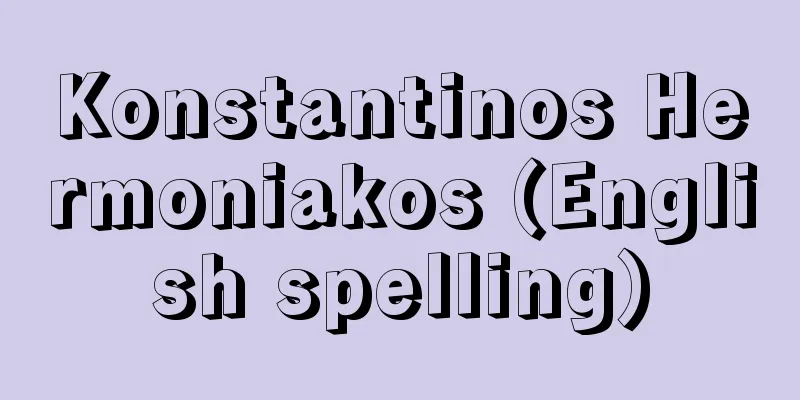
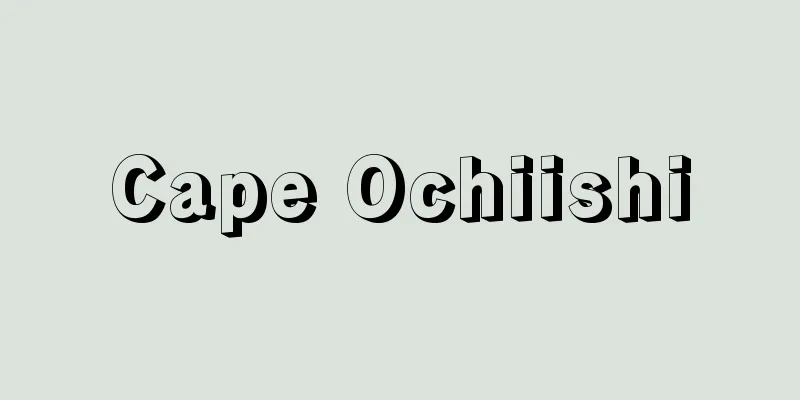


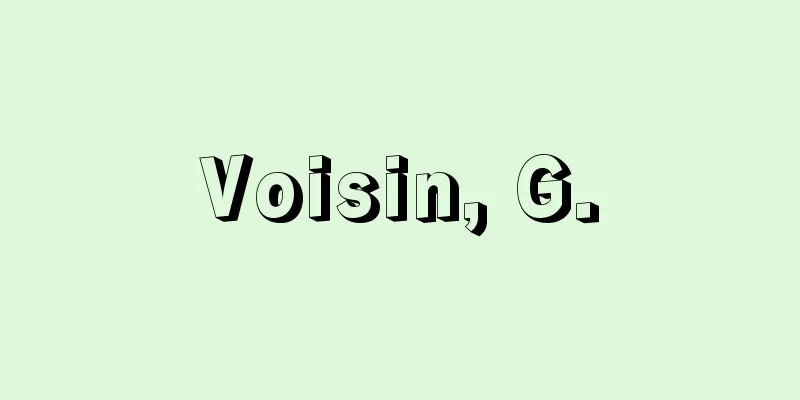

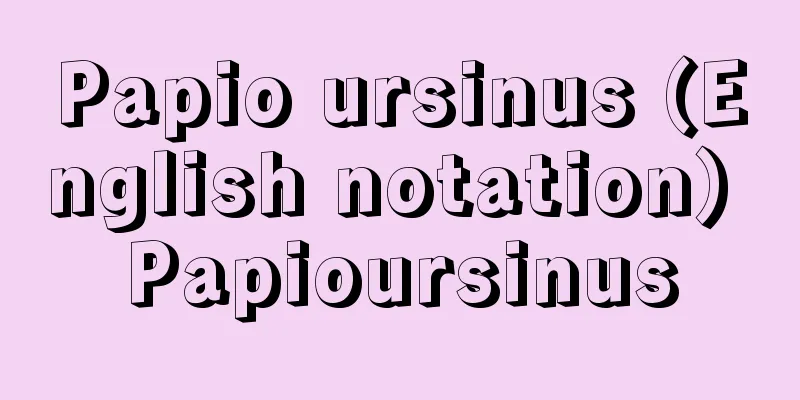

![Agung [mountain] - Agung](/upload/images/67cad23915388.webp)
